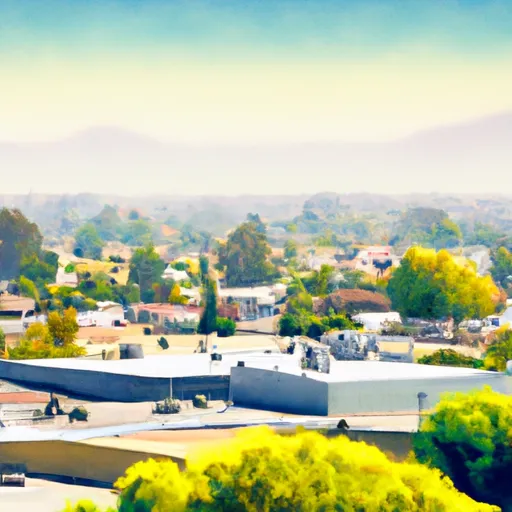-
 Snoflo Premium
Snoflo Premium
Get unlimited access to all our content
With no Ad interruptions! - Start Your Free Trial Login with existing account
Valley-Village
Eden Index
Climate
9.4
•
Recreation
3.6
•
Community
3.0
•
Safeguard
5.8/10

Valley Village is a small neighborhood located in the San Fernando Valley region of Los Angeles, California. The climate in Valley Village is characterized by warm summers and mild winters, with average high temperatures ranging from the mid-70s to mid-90s Fahrenheit (24-35°C) during the summer and mid-60s to low 70s Fahrenheit (16-23°C) during the winter. The area experiences little rainfall, with most precipitation occurring between November and March.
In terms of hydrology constituents, Valley Village is not known for any major bodies of water or rivers. The neighborhood relies on the larger Los Angeles River for its water supply.
Outdoor recreation opportunities in Valley Village are limited within the neighborhood itself, as it is primarily a residential area. However, there are several parks nearby, such as North Hollywood Park and Studio City Park, offering opportunities for picnicking, sports, and leisurely walks. Additionally, Valley Village is conveniently located near the Santa Monica Mountains and the Hollywood Hills, providing easy access to hiking trails and scenic viewpoints for outdoor enthusiasts.
What is the Eden Index?
The Snoflo Eden Index serves as a comprehensive rating system for regions, evaluating their desirability through a holistic assessment of climate health, outdoor recreation opportunities, and natural disaster risk, acknowledging the profound impact of these factors on livability and well-being.
Climate Health Indicator (CHI): 9.4
Valley-Village receives approximately
452mm of rain per year,
with humidity levels near 58%
and air temperatures averaging around
18°C.
Valley-Village has a plant hardyness factor of
10, meaning
plants and agriculture in this region tend to thrive here all year round.
By considering the ideal temperature range, reliable water supplies, clean air, and stable seasonal rain or snowpacks, the Climate Health Indicator (CHI) underscores the significance of a healthy climate as the foundation for quality living.
A healthy climate is paramount for ensuring a high quality of life and livability in a region, fostering both physical well-being and environmental harmony. This can be characterized by ideal temperatures, reliable access to water supplies, clean air, and consistent seasonal rain or snowpacks.
Weather Forecast
Streamflow Conditions
Ventura-San Gabriel Coastal
Area Rivers
Ventura-San Gabriel Coastal
Snowpack Depths
Ventura-San Gabriel Coastal
Reservoir Storage Capacity
Ventura-San Gabriel Coastal
Groundwater Levels
Recreational Opportunity Index (ROI): 3.6
The Recreational Opportunity Index (ROI) recognizes the value of outdoor recreational options, such as parks, hiking trails, camping sites, and fishing spots, while acknowledging that climate plays a pivotal role in ensuring the comfort and consistency of these experiences.
Access to outdoor recreational opportunities, encompassing activities such as parks, hiking, camping, and fishing, is crucial for overall well-being, and the climate plays a pivotal role in enabling and enhancing these experiences, ensuring that individuals can engage in nature-based activities comfortably and consistently.
Camping Areas
| Campground | Campsites | Reservations | Toilets | Showers | Elevation |
|---|---|---|---|---|---|
| Castaic Lake | 60 | 1,184 ft | |||
| Spunky | 10 | 3,191 ft | |||
| Messenger Flats | 10 | 5,793 ft | |||
| Streamside | 9 | 2,364 ft | |||
| Dockweiler Beach RV | 117 | 45 ft |
Catastrophe Safeguard Index (CSI):
The Catastrophe Safeguard Index (CSI) recognizes that natural disaster risk, encompassing floods, fires, hurricanes, and tornadoes, can drastically affect safety and the overall appeal of an area.
The level of natural disaster risk in a region significantly affects safety and the overall livability, with climate change amplifying these risks by potentially increasing the frequency and intensity of events like floods, fires, hurricanes, and tornadoes, thereby posing substantial challenges to community resilience and well-being.
Community Resilience Indicator (CRI): 3.0
The Community Resilience Indicator (CRI) recognizes that education, healthcare, and socioeconomics are crucial to the well-being of a region. The CRI acknowledges the profound impact of these elements on residents' overall quality of life. By evaluating educational resources, healthcare accessibility, and economic inclusivity, the index captures the essential aspects that contribute to a thriving community, fostering resident satisfaction, equity, and social cohesion.

